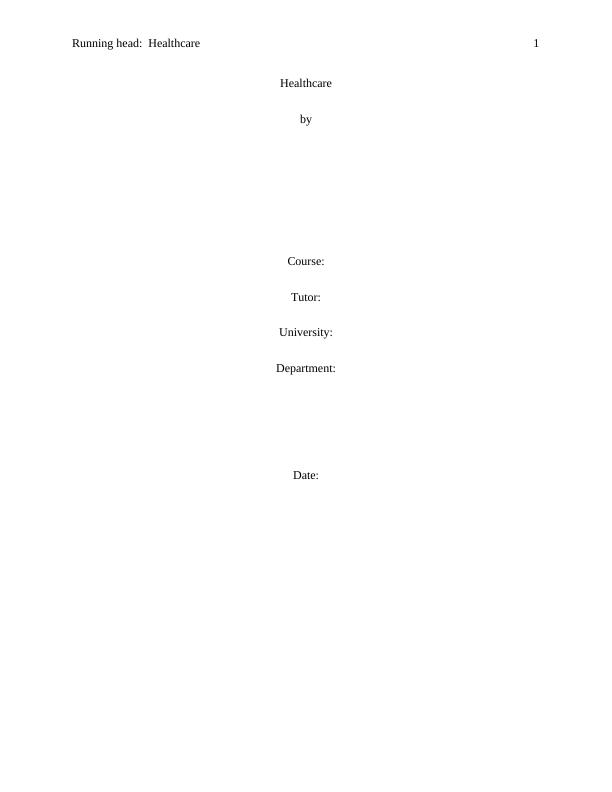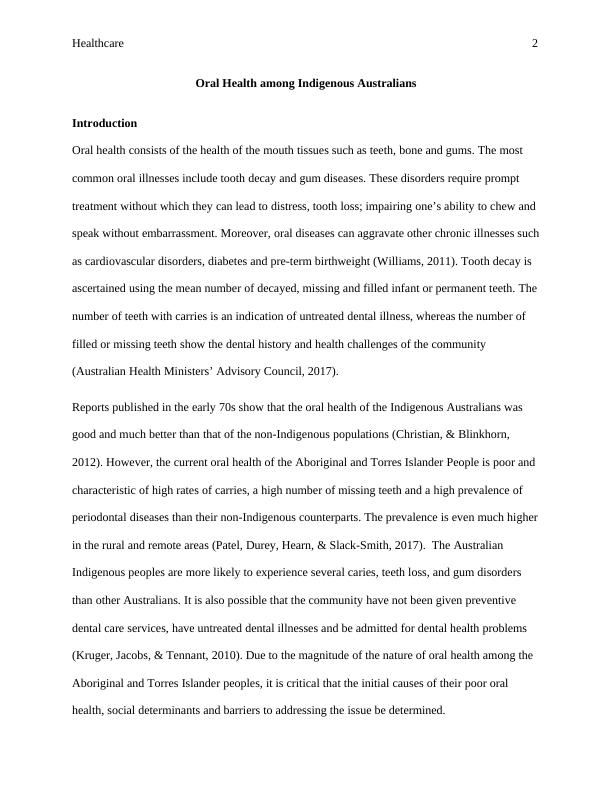Oral Health among Indigenous Australians Issue 2022
Added on 2022-10-15
8 Pages2214 Words14 Views
Running head: Healthcare 1
Healthcare
by
Course:
Tutor:
University:
Department:
Date:
Healthcare
by
Course:
Tutor:
University:
Department:
Date:

Healthcare 2
Oral Health among Indigenous Australians
Introduction
Oral health consists of the health of the mouth tissues such as teeth, bone and gums. The most
common oral illnesses include tooth decay and gum diseases. These disorders require prompt
treatment without which they can lead to distress, tooth loss; impairing one’s ability to chew and
speak without embarrassment. Moreover, oral diseases can aggravate other chronic illnesses such
as cardiovascular disorders, diabetes and pre-term birthweight (Williams, 2011). Tooth decay is
ascertained using the mean number of decayed, missing and filled infant or permanent teeth. The
number of teeth with carries is an indication of untreated dental illness, whereas the number of
filled or missing teeth show the dental history and health challenges of the community
(Australian Health Ministers’ Advisory Council, 2017).
Reports published in the early 70s show that the oral health of the Indigenous Australians was
good and much better than that of the non-Indigenous populations (Christian, & Blinkhorn,
2012). However, the current oral health of the Aboriginal and Torres Islander People is poor and
characteristic of high rates of carries, a high number of missing teeth and a high prevalence of
periodontal diseases than their non-Indigenous counterparts. The prevalence is even much higher
in the rural and remote areas (Patel, Durey, Hearn, & Slack‐Smith, 2017). The Australian
Indigenous peoples are more likely to experience several caries, teeth loss, and gum disorders
than other Australians. It is also possible that the community have not been given preventive
dental care services, have untreated dental illnesses and be admitted for dental health problems
(Kruger, Jacobs, & Tennant, 2010). Due to the magnitude of the nature of oral health among the
Aboriginal and Torres Islander peoples, it is critical that the initial causes of their poor oral
health, social determinants and barriers to addressing the issue be determined.
Oral Health among Indigenous Australians
Introduction
Oral health consists of the health of the mouth tissues such as teeth, bone and gums. The most
common oral illnesses include tooth decay and gum diseases. These disorders require prompt
treatment without which they can lead to distress, tooth loss; impairing one’s ability to chew and
speak without embarrassment. Moreover, oral diseases can aggravate other chronic illnesses such
as cardiovascular disorders, diabetes and pre-term birthweight (Williams, 2011). Tooth decay is
ascertained using the mean number of decayed, missing and filled infant or permanent teeth. The
number of teeth with carries is an indication of untreated dental illness, whereas the number of
filled or missing teeth show the dental history and health challenges of the community
(Australian Health Ministers’ Advisory Council, 2017).
Reports published in the early 70s show that the oral health of the Indigenous Australians was
good and much better than that of the non-Indigenous populations (Christian, & Blinkhorn,
2012). However, the current oral health of the Aboriginal and Torres Islander People is poor and
characteristic of high rates of carries, a high number of missing teeth and a high prevalence of
periodontal diseases than their non-Indigenous counterparts. The prevalence is even much higher
in the rural and remote areas (Patel, Durey, Hearn, & Slack‐Smith, 2017). The Australian
Indigenous peoples are more likely to experience several caries, teeth loss, and gum disorders
than other Australians. It is also possible that the community have not been given preventive
dental care services, have untreated dental illnesses and be admitted for dental health problems
(Kruger, Jacobs, & Tennant, 2010). Due to the magnitude of the nature of oral health among the
Aboriginal and Torres Islander peoples, it is critical that the initial causes of their poor oral
health, social determinants and barriers to addressing the issue be determined.

Healthcare 3
Prevalence of Oral Health Diseases among Indigenous Australians
According to a social survey conducted by Australian Health Ministers’ Advisory Council
(2017) in 2014-2015, 28% of the Aboriginal and Torres Islander children aged fifteen years and
below had teeth or gum health issues. Dental decay or cavities accounted for the most prevalent
oral disease (12%), 11% attributed to dental decay, braces/retainer cases (6%) and dental decay
and removal of teeth (5%). 56% of the Indigenous children with teeth or gum related issues had
had the experience for the past one year. An estimated 29% had gone for a dental check-up in the
past three months or less. 8% of the Indigenous children diagnosed with oral health issues had
never seen a dentist whereas six per cent with gum or teeth issues and had been recommended to
a dentist had never done so over the past one year. The parents said that seeing a dentist was
costly (28%), the doctors time conflicted with their availability of waiting time was too much
(18%).
Just like the Indigenous children, the adults also have oral health problems and are in need for
dental treatment than other Australian adults especially in extractions, fillings and dentures
(Armfield, Slade, & Spencer, 2009). They also have a high prevalence of caries and missing
teeth and a minimal number of filled teeth. Australian Indigenous adults have also been reported
to have the periodontal disease compared to non-Indigenous adults and are more likely to
develop severe periodontal disease (Butten et al., 2019). 30% of tooth loss is caused by
periodontal disease which is the leading cause for missing teeth among Indigenous adults.
Impact of History of Colonization on Oral Health of Indigenous Australians
Prior to the 1970s, reports have indicated that oral health of the Indigenous Australians was far
much better than other Australians. However, it is currently recognized that oral health among
Indigenous Australians is very poor compared to that of the non-Indigenous community. All
Prevalence of Oral Health Diseases among Indigenous Australians
According to a social survey conducted by Australian Health Ministers’ Advisory Council
(2017) in 2014-2015, 28% of the Aboriginal and Torres Islander children aged fifteen years and
below had teeth or gum health issues. Dental decay or cavities accounted for the most prevalent
oral disease (12%), 11% attributed to dental decay, braces/retainer cases (6%) and dental decay
and removal of teeth (5%). 56% of the Indigenous children with teeth or gum related issues had
had the experience for the past one year. An estimated 29% had gone for a dental check-up in the
past three months or less. 8% of the Indigenous children diagnosed with oral health issues had
never seen a dentist whereas six per cent with gum or teeth issues and had been recommended to
a dentist had never done so over the past one year. The parents said that seeing a dentist was
costly (28%), the doctors time conflicted with their availability of waiting time was too much
(18%).
Just like the Indigenous children, the adults also have oral health problems and are in need for
dental treatment than other Australian adults especially in extractions, fillings and dentures
(Armfield, Slade, & Spencer, 2009). They also have a high prevalence of caries and missing
teeth and a minimal number of filled teeth. Australian Indigenous adults have also been reported
to have the periodontal disease compared to non-Indigenous adults and are more likely to
develop severe periodontal disease (Butten et al., 2019). 30% of tooth loss is caused by
periodontal disease which is the leading cause for missing teeth among Indigenous adults.
Impact of History of Colonization on Oral Health of Indigenous Australians
Prior to the 1970s, reports have indicated that oral health of the Indigenous Australians was far
much better than other Australians. However, it is currently recognized that oral health among
Indigenous Australians is very poor compared to that of the non-Indigenous community. All

End of preview
Want to access all the pages? Upload your documents or become a member.
Related Documents
Oral Health among Indigenous Australians PowerPoint Presentation 2022lg...
|12
|1036
|8
Nursing Oral Health Essay 2022lg...
|12
|2728
|24
(PDF) Oral Health Equals Total Healthlg...
|7
|2190
|28
Dental and Oral Health in Australia and Queenslandlg...
|9
|1946
|29
Indigenous Children Dental Healthlg...
|7
|2360
|455
Raising Awareness of Occupational Risks in Dentistrylg...
|24
|8398
|99
